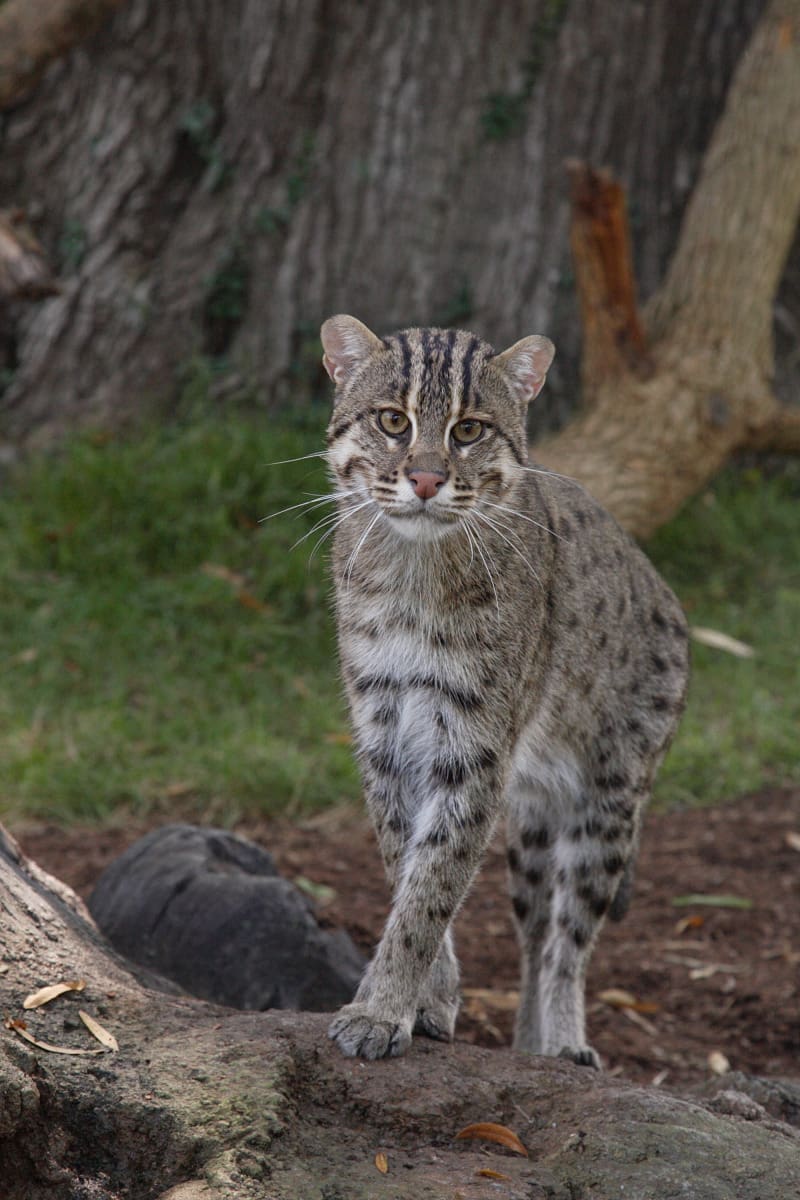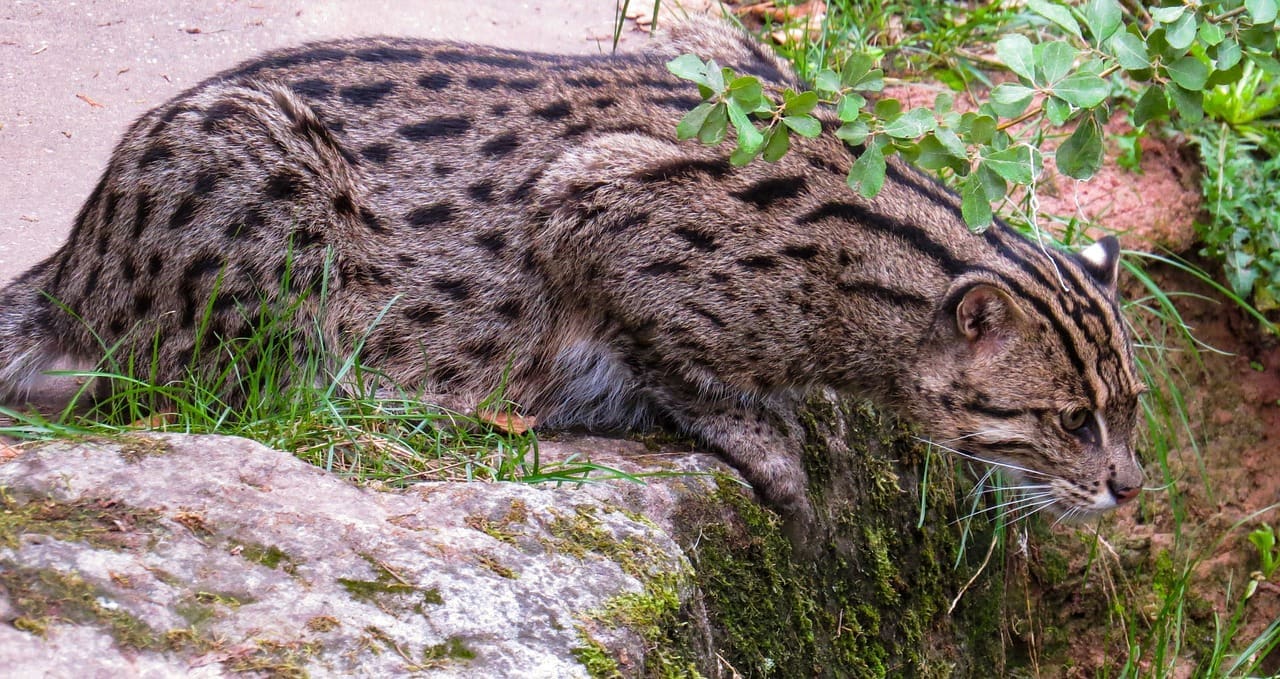What fascinating feline with unique adaptations roams the aquatic ecosystems of Southeast Asia?
The fishing cat, otherwise known as Prionailurus viverrinus!
One Clever Cat
Venturing into the world of fishing cats unveils a marvel of feline prowess and adaptability. These incredible creatures, found across 11 countries in Southeast Asia, possess a unique combination of features that defy conventional feline stereotypes.
Their distinct traits include a squat, stocky build, equipped with short, webbed feet, and an olive-gray coat adorned with black spots and stripes. Contrary to the belief that cats avoid water at all costs, fishing cats exhibit an unparalleled affinity for aquatic habitats. Indeed, these exceptional swimmers and adept hunters inhabit wetlands, marshes, and mangrove forests.
One of the most striking features aiding the waterborne adventures of the fishing cat is the webbing between their toes, facilitating seamless navigation through muddy wetlands without sinking. Additionally, their fur boasts a dual-layered composition: a short, dense undercoat shields their skin from the elements while swimming, while longer guard hairs contribute to their distinctive coloration, providing ideal camouflage for hunting in varied terrains.
Hunting primarily near water bodies, fishing cats display remarkable adaptability in their diet, feasting not only on fish but also on crustaceans, amphibians, and various aquatic creatures. These agile predators employ ingenious techniques, using their paws to scoop fish from shallow waters or even diving headfirst into deeper areas to secure a meal with their teeth. Their versatile diets extend to snakes, rodents, and even larger prey like young deer and wild pigs, but fish comprise about three quarters of their food.
Watch a juvenile try to learn the process:
Fishing cats navigate diverse ecosystems with ease, forging their existence in habitats ranging from freshwater landscapes to coastal regions. While much of their behavior in the wild has eluded observation, fishing cats, which are nocturnal animals, are thought to have no natural predators besides humans. They tend to roam wetlands and areas that larger cats and predators aren’t well suited to inhabit. However, humans provide plenty of issues to contend with, and due to the pressures of habitat encroachment, development, and poaching, fishing cats are classified as a vulnerable species.

Human and Habitat Pressures
In India, conservationists and researchers have embarked on a pivotal journey to safeguard these elusive creatures. The country’s many wetland ecosystems, integral to the fishing cat’s survival, face mounting threats from human encroachment, urbanization, and environmental degradation. Increasing development comes with issues of draining wetlands, polluting them, or altering their composition and natural salinity of the soil due to aquaculture operations.
Many organizations, like the Wildlife Institute of India and the Eastern Ghats Wildlife Society, have sprung up to champion the cause of fishing cats and understand more about these creatures. Studies conducted in sanctuaries and wildlife reserves have shed light on the behavior, habitat preferences, and dietary patterns of fishing cats in captivity. Initiatives to map their territories and understand their population dynamics have proven more challenging, yet vital for conservation strategies. Camera trap surveys in regions like the Coringa Wildlife Sanctuary and the Krishna Wildlife Sanctuary have uncovered pockets of fishing cat populations, offering valuable insights into their distribution across diverse landscapes.

The evolving understanding of fishing cats has inspired conservation campaigns aimed at raising awareness among local communities. Educational programs, including the “Children for Fishing Cats” initiative, have empowered younger generations to become advocates for wildlife conservation, fostering harmony between human activities and the preservation of vital ecosystems.
Amidst the growing threats posed by habitat loss, human-wildlife conflicts, and climate change, conservationists advocate for stronger legislation and reinforced protection measures for wetlands and associated habitats. Efforts to mitigate conflict situations, prevent retaliatory killings, and promote sustainable practices among fishing communities stand as cornerstones in safeguarding these resilient creatures and their fragile environments.
As researchers navigate the delicate balance between human activities and wildlife conservation, the overarching goal remains clear: preserving the wetlands that sustain the extraordinary fishing cats is indispensable for safeguarding biodiversity, ensuring ecological resilience, and fostering coexistence between humans and these remarkable felines. More people and organizations are also coming to appreciate the benefits of healthy wetland ecosystems for buffering against storm surges, protecting water quality, contributing to the water cycle, and helping fight climate change.
As we protect and restore our wetlands, we can safeguard the future for fishing cats, the ecosystems they regulate, and the web of life that connects us.
For my fellow water lovers everywhere,
Maya

Maya Dutta is an environmental advocate and ecosystem restorer working to spread understanding on the key role of biodiversity in shaping the climate and the water, carbon, nutrient and energy cycles we rely on. She is passionate about climate change adaptation and mitigation and the ways that community-led ecosystem restoration can fight global climate change while improving the livelihood and equity of human communities. Having grown up in New York City and lived in cities all her life, Maya is interested in creating more natural infrastructure, biodiversity, and access to nature and ecological connection in urban areas.
Sources:
https://www.bbc.com/future/article/20210416-the-fight-to-save-indias-most-elusive-cat
https://animals.sandiegozoo.org/animals/fishing-cat
https://en.wikipedia.org/wiki/Fishing_cat
https://nationalzoo.si.edu/animals/fishing-cat




